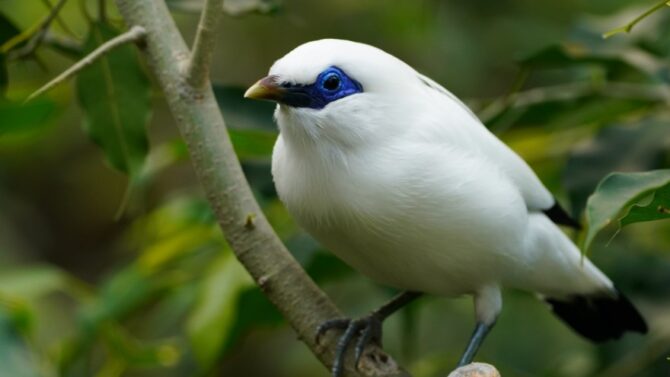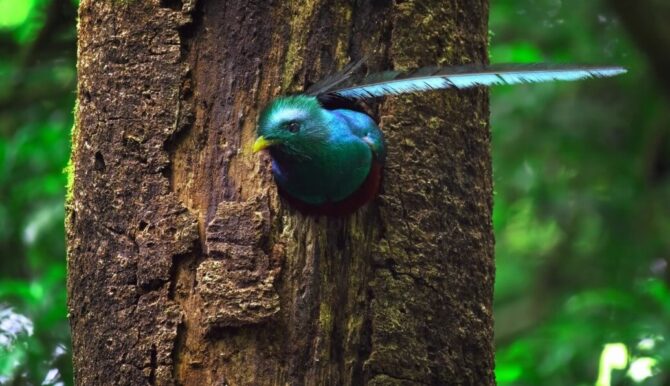Birds are arguably the most beautiful creatures in the world, with plumes of bright colors and aerodynamics that awe the world.
Sadly, many of these beautiful creatures are going extinct due to human activity, global warming, deforestation, and other world-changing conditions.
Researchers reveal that one in six species is threatened with extinction, driving them to extreme rarity.1
Read on to discover the top ten rarest birds in the world, including the South Philippine dwarf kingfisher, kakapo, and New Caledonian owlet-nightjar, and where to find them.
Also, find out about conservation and breeding efforts worldwide trying to protect our feathery friends.
Without further ado, let us dive in!
The Rarest Birds in the World
10. California Condor
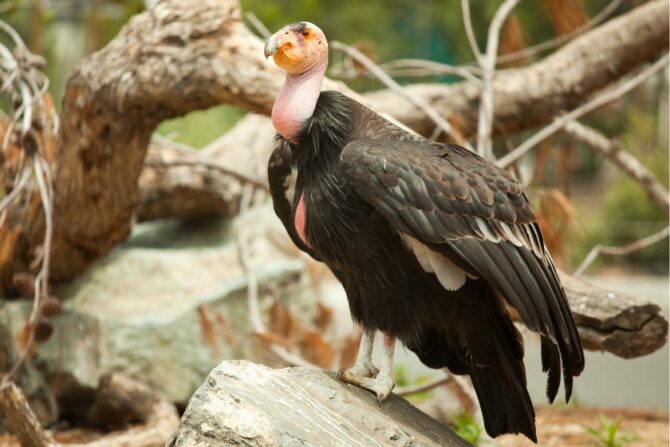
- Scientific Name: Gymnogyps californianus
- Length: 43 – 55.1 inches
- Weight: 7-14.1 kg
- Wingspan: 9 feet, 10 inches
- Identifying features: Large triangular patches or bands on the wings underside; gray legs and feet; ivory-colored bill; frill of black feathers surrounding the neck base; brownish red eyes.
- Where found: United States of America, Mexico
- Conservation Status: Critically Endangered
North America’s largest bird is the magnificent but critically endangered California Condor.
These magnificent gliders travel worldwide but mostly inhabit the deserts of central and southern California, where they nest on cliffs to feast on the carcasses of animals.
The largely bald vulture became extinct in the wild in 1987.
Remarkably, breeding populations now exist in the wild following the reintroduction of captured individuals to the coastal mountains of California, southern Utah, northern Arizona, and northern Baja California in Mexico.
The U.S. implemented a conservation process, possibly one of its most expensive animal conservation projects, costing over 35 million dollars and averaging two million dollars annually in 2007.
A couple of U.S. National Parks, including the Grand Canyon National Park, Pacific Coast Science and Learning Center, and Pinnacles National Park, present sights of one of the world’s rare birds.2
Related: Weird Birds – The Most Bizarre & Strangest Species In The World
9. Imperial Amazon
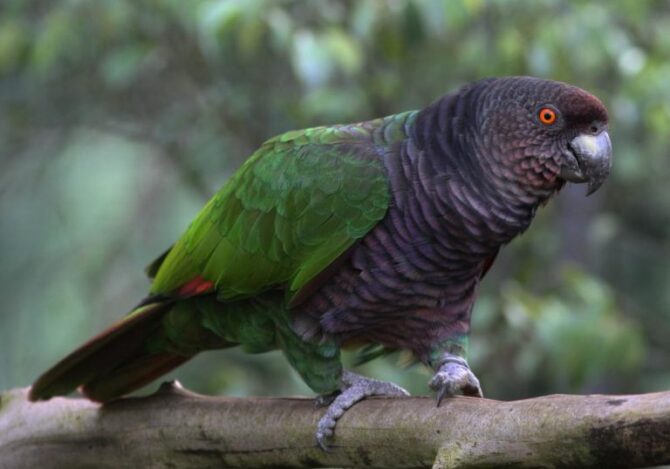
- Scientific Name: Amazona imperialis
- Length: 19 inches
- Weight: 0.652 kg – 0.9 kg
- Identifying Features: Green and violet-blue plumes; brown and blue-colored underwings.
- Where Found: Dominica
- Conservation Status: Critically Endangered
One might feel that it is difficult to detect the Imperial Amazon because their plumage camouflages them well; however, their rarity comes down to more than their camouflage.
The Imperial Amazon is a critically endangered species endemic to the Caribbean’s Dominica, a significant animal in the country that appears on its flag.
As of 2019, about fifty mature individuals remained in the wild. Remarkably, Dominica’s Forestry, the Rare Species Conservatory Foundation (RSCF), and Wildlife and Parks Division protect the Central and Northern Forest Reserve, where the Imperial Amazon exists.
The Morne Trois Pitons National Park is a great place to find the Imperial Amazon.
8. Bali Myna
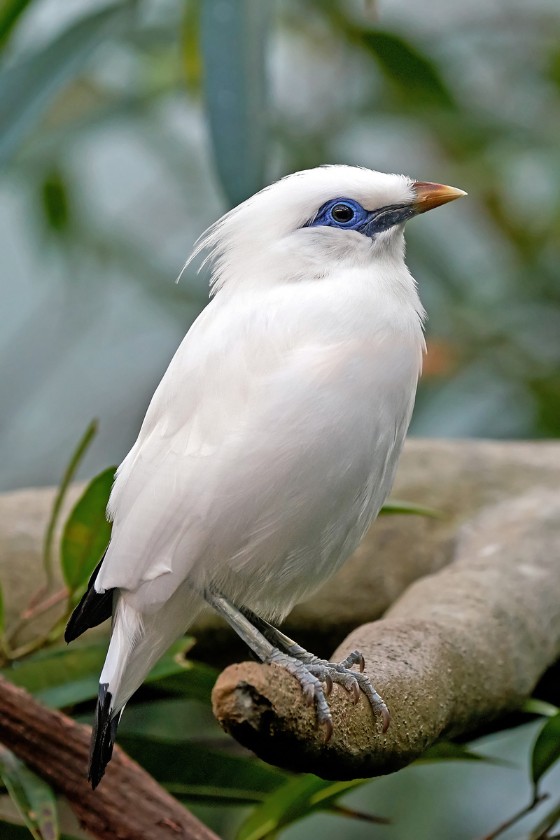
- Scientific Name: Leucopsar rothschildi
- Length: 25cm
- Weight: 0.075 – 0.095 kg
- Wingspan: 1 foot, 8 inches – 1 foot, 10 inches
- Identifying features: Long, drooping crest; black wing and tail tips; yellow bill; bare blue skin around the eyes and legs.
- Where found: Indonesia
- Conservation status: Critically Endangered
The Bali myna is draped in white, with wings and tail plumes black at the tip and blue skin around its eyes; undoubtedly, this medium-sized bird presents a stunning sight.
Bali mynas can be seen in the mountains near Bali’s north coast. The birds typically group in flocks of twenty to thirty, occupying tree holes and using leaves to line their nests.
Termites, caterpillars, other insects, small reptiles, and worms constitute the Bali myna’s diet. They are a monogamous breed, as their nest is home to the eggs they have each year.
One can find the Bali myna in the Bali Barat National Park in Indonesia, where it was reintroduced to re-establish a population in the wild.
7. Cebu Flowerpecker
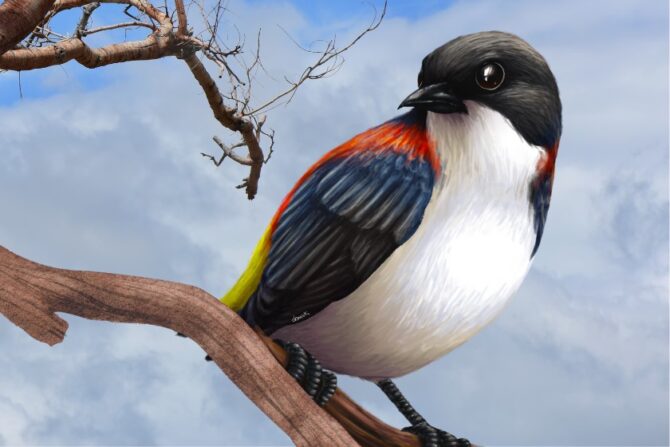
- Scientific Name: Dicaeum quadricolor
- Length: 4 inches
- Identifying Features: Whitish underparts; black upperparts; red back and an orange rump in males; gray-brown upperparts; olive wings in females.
- Where Found: Philippines
- Conservation Status: Critically Endangered
The Cebu flowerpecker is endemic and restricted to the Philippines’ Cebu Islands. While the bird is rated “Critically Endangered” by the IUCN, it was thought extinct until 1992 when a population emerged in the Central Cebu Protected Landscape.
The bird’s supposed extinction was attributed to habitat loss, as only 0.03% of its original forest habitat remained in the 1990s.
Their scientific name, Dicaeum quadricolor, is befitting, considering the male’s blue, red, white, and yellow plumage.
The Cebu flowerpecker is upsettingly rare, with a few over 100 individuals in the wild. Remarkably, efforts are in place to ensure the continuity of this species.
The Tabanan Forest, Babayungan Forest in Dalaguete, and the Nug-as Forest in Alcoy, Cebu, Philippines, are some of the best places to find the Cebu flowerpecker.
6. New Caledonian Owlet Nightjar

- Scientific Name: Aegotheles savesi
- Length: 11 inches
- Identifying Features: Grey-brown and black plumage; rounded wings; long, short, stout legs; slightly rounded tail.
- Where Found: New Caledonia
- Conservation Status: Critically Endangered
The New Caledonian owlet nightjar is one of the world’s most mysterious but rarest birds, perhaps because its voice is unknown, unlike other owlet nightjar species that make whistling and churring sounds.
Before the twentieth century, only two New Caledonian owlet nightjars were estimated, with the number increasing to a few by 1915.
Even now, less than fifty New Caledonian owlet nightjars remain in the wild, and their population keeps declining.
5. Blue-Eyed Ground Dove

- Scientific Name: Columbina cyanopis
- Length: 6.1 inches
- Weight: 0.035 kg
- Identifying Features: purplish red neck, head, wing, and upper tail coverts, and breast; brown lower breast, belly, flanks, shoulders, and back; white vent and undertail covert; dark brown and chestnut with iridescent blue spots closed wing; blue eye surrounded by bare gray skin.
- Where Found: Brazil
- Conservation Status: Critically Endangered
The blue-eyed ground dove is one of the rarest dove species in the world, with an extremely small population.
The bird is endemic to Brazil’s Cerrado region but was thought extinct for many years until a rediscovered population emerged in 2015.
These birds are admired for their striking blue eyes, complemented by blue spots on their wings.
A protected area in Serra das Araras Ecological Station is the best place to find the blue-eyed ground dove.
4. Kākāpō
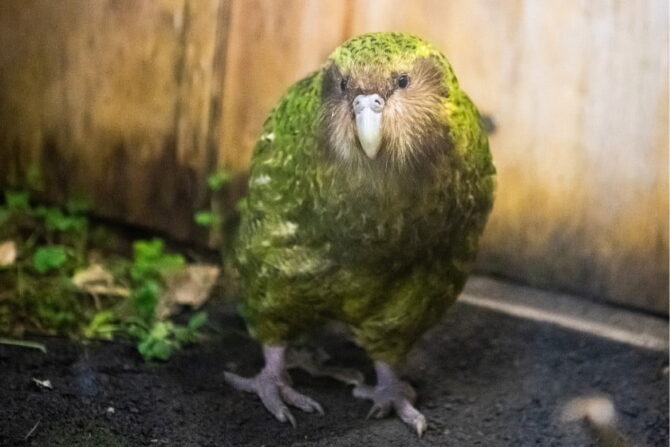
- Scientific name: Strigops habroptilus
- Length: 25.1 inches
- Weight: 1.5 – 3 kg
- Identifying features: Blotched yellow-green plumage; large blue feet; distinct facial disc; large grey beak; owl-style, forward-facing eyes, with surrounding discs of specially-textured feathers; short legs; relatively short wings and tail.
- Where found: New Zealand
- Conservation status: Critically endangered
The kākāpō is not as big as the ostrich or some of the world’s largest flightless birds, but it is a large, flightless, ground-dwelling parrot endemic to New Zealand.
While it is a flightless bird, the kākāpō is an outstanding climber with d strong legs to support its ground-dwelling ability.
Human arrival in New Zealand negatively affected kākāpō populations in the country, with only fifty individuals left in the 1990s.
In 2022, there are no kākāpōs remaining in the wild, but the population increased to 252 birds after several conservation efforts over the years.3
The Whenua Hou, Hauturu Nature Reserves, and Anchor Island are destinations to find the kākāpō.4
3. Rufous-headed Hornbill

- Scientific name: Aceros waldeni
- Length: 31-36cm
- Weight: 0.07 – 0.125 kg
- Identifying features: Cream-colored tail with a black terminal band; orange casque; wrinkled lower bill; yellow pouch and markings around the males’ eyes; blue and yellow markings around females’ eyes and on the chin.
- Where found: Philippines
- Conservation status: Critically Endangered
Know by several names like Walden’s hornbill, Visayan wrinkled hornbill, or writhed-billed hornbill, this species of hornbill is primarily characterized by a bony casque that
extends from the top of its wrinkly red-orange bills. Rufous-headed hornbills are endemic to Panay Islands in the Philippines; however, small groups of these birds, like most hornbill species, reside on the islands of Negro.
The Walden’s hornbill builds its nest in naturally occurring or man-made hollows in tree trunks, procreating slowly, like other hornbills, which could be a reason for its possible extinction and rarity.
Their diet consists mainly of fruits, including prey like snails, beetles, and caterpillars.
One might find a few rufous-headed hornbills in the Central Panay Mountain Range, but in captivity in the Mari-it Wildlife and Conservation Park and Talarak Foundation, all in the Philippines.
2. Madagascar Pochard
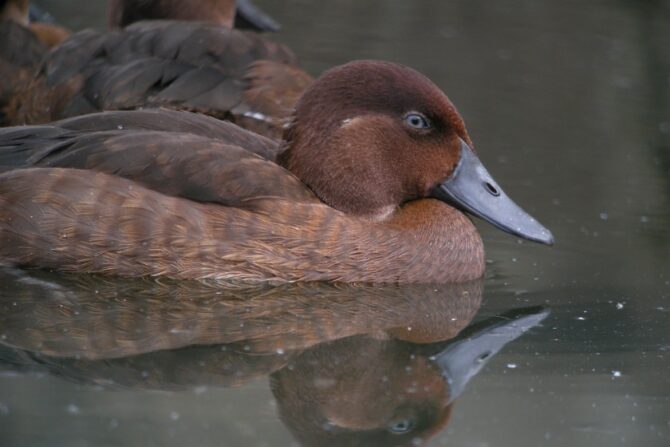
- Scientific name: Aythya innotata
- Length: 17.7 – 22.0 inches
- Weight: 0.685 kg
- Wingspan: 7.8 inches
- Identifying features: Brown irises; pale, dull brown or chestnut plumes with a darker stomach; dark chestnut heads, chins, throats, breasts, and necks in breeding males; dark brown wings with a white bar; dark gray beaks and legs; white gradient from the stomach to the tail.
- Where found: Madagascar
- Conservation status: Critically Endangered
The Madagascar Pochard is a duck species once considered extinct until just a few feet away from Lake Alaotra; at Lake Matsaborimena, a few Madagascar pochard sightings in a long time came into the record in 2006.
Lakes, pools, and marshes with open-water and vegetation-filled islets should be habitats for the Madagascan Pochard.
However, only a few individuals exist in the wild in Lake Sofia, Madagascar, thanks to breeding and conservation efforts; others are reared in captivity at the captive breeding center in Antsohihy.
The Madagascan Pochard frequently appears alone, in pairs, or in compact groups of three. Insects make the Madagascan Pochard’s primary menu.
However, since it eats mostly by diving, it likely ingests seeds and aquatic plant components.
1. Stresemann’s Bristlefront
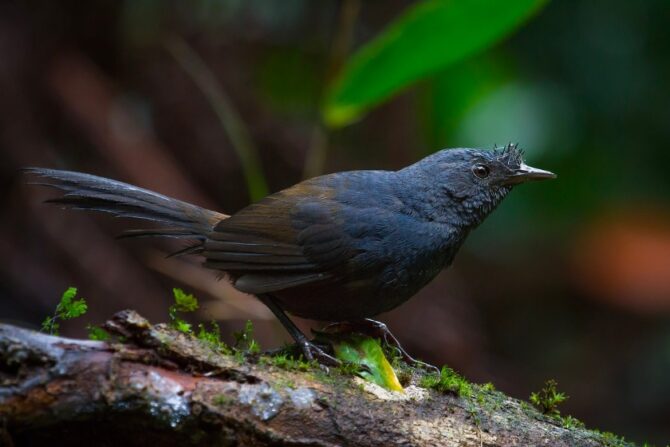
- Scientific Name: Merulaxis stresemanni
- Length: 7.8 inches
- Identifying features: Males – gray with a dark rufous-chestnut rump, upper tail coverts, and vent; females – cinnamon-brown, with a duskier tail and bright cinnamon below.
- Where found: Brazil
- Conservation status: Critically Endangered
Stresemann’s Bristlefront, native to Brazil, is very close to extinction. This songbird inhabits subtropical or tropical moist lowland woodland but only occurs in the Mata do Passarinho Reserve.
Due to its exceedingly reduced population, most likely below fifty, little is known about its ecology and behavior.5
However, researchers have observed that the bird forages in pairs and feeds on insects, and its song is similar to its counterpart, the slaty bristlefront, but in a lower pitch.
Stresemann’s Bristlefront has a small ecological range, occurring within the Mata do Passarinho’s fourteen square mile forest, a habitat suffering from rapid deforestation.
Frequently Asked Questions
Can birds die from glass collisions?
Yes, several birds die from glass collisions, reaching one billion annually in the United States. Glass windows pose a great challenge to birds, especially when plants are reflected in the windows since they see differently from humans.
Do pesticides affect birds?
Birds can die from toxic pesticides; even seed treatments and insecticides can be toxic to birds, impairing their migratory ability. Research reveals that one seed treated with neonics can kill a songbird, while less than a seed can impair its reproduction.
How may your cat contribute to killing vulnerable species?
Cats have a high prey drive and may instinctively hunt or kill birds, especially ground-dwelling species. However, you can keep it safely contained outdoors or indoors to create a safe environment for birds.
How can you save birds from extinction?
It’s possible to contribute your quota to saving our colorful, feathery friends from possible extinction. Some of these ways include making your windows bird-safe, help reducing climate change, avoiding using chemical fertilizers and pesticides, making your yard a haven for birds, teaching your pets not to go against birds, and donating or involving in a nature conservation group.
Wrap Up
A colorful bird on your lawn could be the most beautiful sight sometimes. Other times, a bird’s songs could be the most beautiful tune you hear.
Our feathery friends differ in species; some might disappear if conservative measures are ignored, as they are already rare.
However, it takes conservative efforts and supports to ensure the continuity of these birds as human activities, climate change, and other challenges force them into extinction.
We implore all to support the existence of the world’s rarest birds and do their best not to endanger species with little concern.
Next up…
References & Notes
Facts Sources:
- Mark C. Urban. 2015. Accelerating extinction risk from climate change. Science.
- Condors in Parks. NPS.
- Craymar L. New Zealand’s endangered kakapo parrot gets a big population boost. Reuters.
- Kākāpō habitat and islands. Department of Conservation, New Zealand.
- Stresemann’s Bristlefront. Birds of the World, Cornell Lab of Ornithology.
